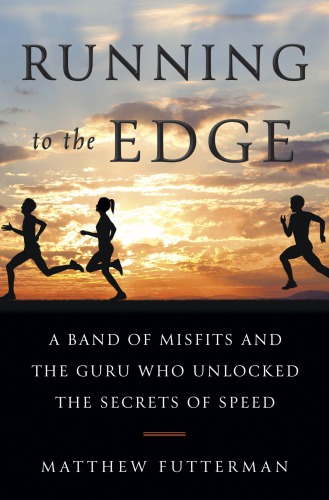
Running to the Edge
A Band of Misfits and the Guru Who Unlocked the Secrets of Speed
کتاب های مرتبط
- اطلاعات
- نقد و بررسی
- دیدگاه کاربران
نقد و بررسی

April 1, 2019
New York Times sports editor Futterman enthusiastically documents the life of renowned American running coach Bob Larsen. Larsen grew up on a remote farm in 1940s Minnesota before moving to Southern California. There, he competed throughout high school and at San Diego State College. He realized that running faster wasn’t a result of the injury-inducing sprint-track workouts his coaches had relied on, but instead came from gradual increased mileage and intensity. After college, he coached and formed a number of running teams, among them the rag-tag Jamul Toads, which surprised the running world by winning the 1976 AAU National Cross Country Championship. In 1979, Larsen began coaching track at UCLA, where he became an early adopter of altitude training, which he later used for marathoners Deena Kastor, who won the 2004 Olympic bronze medal, and Meb Keflezighi, who won the 2004 Olympic silver medal. Throughout, Futterman makes physiology easily understandable (“When a body trains hard, it has to break down carbohydrates and glycogen to use them for energy”) and shares his own story of qualifying for and competing in his dream race: the 2018 Boston Marathon. This fast-paced sports history serves as an inspirational road map for runners.

May 15, 2019
The deputy sports editor for the New York Times chronicles a key figure in the development of modern track. Why run? In a lively narrative, Futterman (Players: The Story of Sports and Money, and the Visionaries Who Fought To Create a Revolution, 2015) writes that it's in part to fight death, for relative to an ordinary person, "the well-trained body has far more glycerol, which breaks down fatty tissue, and far less allantoin, which can bring on a condition known as oxidative stress that causes cell damage." Running, by those lights, is a form of resistance against decay and demise. These are the sorts of ideas that intrigued Bob Larsen, a scientifically and philosophically minded coach. In the early 1970s, he rounded up a bunch of hippie jocks, known to sports history as the Jamul Toads, and set out to condition the young runners in ways that coaches had not considered before--running off track, running in extremes of heat and altitude, and the like, carefully gauging the effects of these conditions on performance. Larsen would go on to coach generations of runners, all the while employing the ethic of "running to the edge of exhaustion, the very foundation of every lesson Bob has delivered to every runner he had guided in the past forty years as he quietly writes the bible of distance running in the U.S." Futterman chronicles plenty of thrills and spills, as well as the inevitable disappointments, on the road to winning Olympic squads and marathon champions, a development accompanied by lots of good science--running while slightly dehydrated, for instance, leads the body to produce more blood plasma, and "the increased plasma works to bring red blood cells to muscles that are under stress." Ultimately, Larsen clearly understands what motivates runners in the endless rise and fall of competition: "He believes in rising." Athletes in any sport stand to learn from Larsen's methods, and Futterman turns in a fluent yarn reminiscent of Plimpton and McPhee.
COPYRIGHT(2019) Kirkus Reviews, ALL RIGHTS RESERVED.

Starred review from June 1, 2019
At the start of Bob Larsen's (b. 1939) career, distance runners ran track intervals for training. Larsen's upbringing in rural Minnesota, where he was introduced to the joy of running as a quicker way to get around, led him to believe that there might be a better way to train to run faster for longer periods of time. Futterman (deputy sports editor, New York Times) tracks Larsen's early life, his career as a high school track coach near San Diego, and his later work coaching the Jamul Toads, a local running group that took on elite clubs in national championships. A theme of innovative training and always being the underdog emerges, until Larsen is chosen as the University of California Los Angeles's track coach at a time when distance running was an afterthought. After retiring, Larsen jumps back in the distance mix by coaching several Olympic hopefuls, including Deena Kastor and Meb Keflezighi, using a new theory of training at high altitude. Anyone running today is more than likely using training techniques developed by Larsen. VERDICT A fascinating look at the history of U.S. distance running with plenty of grit, innovative approaches, near disasters, and fun.--Zebulin Evelhoch, NC LIVE, Raleigh
Copyright 2019 Library Journal, LLC Used with permission.

May 15, 2019
Futterman, New York Times deputy sports editor and author of Players (2016), about how sports became a business, does a masterful job of chronicling the life story of legendary running coach Bob Larsen, from his humble beginnings on a Minnesota farm to his years at UCLA, and on to his career as a top-level running coach, leading a resurgence of American distance runners including Olympic medalists Meb Keflezighi and Deena Kastor. Larsen can be credited with launching high-altitude training camps and honing the training methodology to "run far and run fast." Readers eager for a compelling underdog sports story are sure to enjoy this account, as many will see themselves in the band of "misfits" Futterman profiles, young rebels who formed the infamous San Diego-based running club, the Jamul Toads. Futterman, an experienced marathoner, includes brief excerpts about his own running experiences, further showing his passion for the sport. Keflezighi's memoir, 26 Marathons (2019), and Kastor's Let Your Mind Run (2018) make great read-alikes for this reverent tribute to a beloved coach.(Reprinted with permission of Booklist, copyright 2019, American Library Association.)

























دیدگاه کاربران